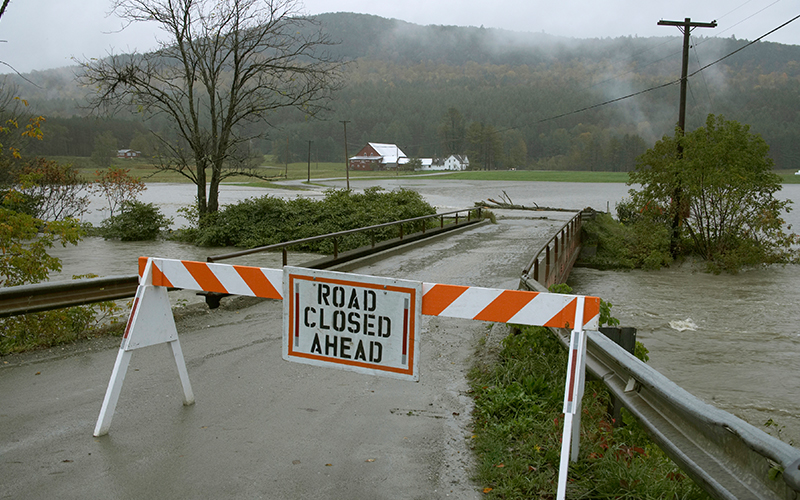The continued deterioration of Meadow Road bridge over the Mad River in Waitsfield has prompted the Waitsfield Select Board to issue an eight-ton limit for the bridge with. No exceptions except for public safety vehicles and town road crews. All other overweight vehicles must use alternate routes.
The status of the bridge has been on the board’s radar for years, but it became critical after July 2024 flooding closed several other bridges and routes, causing a significant increase in traffic on the one-lane bridge.

At its November 10 meeting this week, the board revoked previously granted exemptions to the eight-ton limit. Town administrator York Haverkamp said that after extensive work with VTrans and the Central Vermont Regional Planning Commission, the town is faced with either posting the bridge at eight-ton with no exceptions other than those two, or closing it altogether.
NEW ENGINEERING ASSESSMENTS
This move comes after the town learned that new engineering assessments revealed worsening structural damage that could threaten the safety of drivers and the longevity of the bridge. This comes after months of discussion about the aging structure, which connects Meadow Road to Route 100 and serves residents, delivery trucks, and local school buses.
Board chair Brian Shupe said the decision reflects the town’s growing concern that heavy vehicles are accelerating the bridge’s decline. “We can’t afford to wait until it becomes unsafe,” he said. “Our goal is to make a real effort to keep the larger trucks off this bridge and prevent further damage while we plan for the long-term solution.”
The latest inspection, found multiple signs of distress in the steel I-beams and decking, along with expanding cracks in the abutments and new potholes in the driving surface. Scribner’s report characterized the deterioration as “progressive,” meaning it will continue to worsen if left unaddressed.
Photographs taken during the inspection show deflection and corrosion beneath the deck – particularly on the western approach – along with spalling concrete where water and road salt have penetrated. Patchwork repairs may no longer be sufficient.
After meeting this week, the town will register with the Vermont Department of Motor Vehicles (DMV) which allows the town to post the bridge’s new weight restrictions in the state’s enforcement database. Once listed, local and state police can issue fines to drivers who exceed the posted limit.
Haverkamp said he wants to see consistent enforcement and public visibility. “We’ll make sure the signage is clear, and we’ll look at adding a camera to collect data,” he said. “If we can catch violators once, maybe they won’t do it again.”
ADDITIONAL PATROLS
Haverkamp also suggested coordinating with the Washington County Sheriff’s Department for additional patrols during peak traffic hours. “Even a few hours a week could make a difference,” he said.
The board discussed how restrictions will affect local access, particularly for school buses, propane delivery trucks, and emergency vehicles.
Select board vice-chair Larissa Ursprung said the board would reach out directly to the Harwood Unified Union School District to confirm the weight of its buses and discuss possible adjustments to routes. “We want to make sure they understand the risk and that we’re not putting anyone in a difficult position,” Ursprung said.
The town will also contact major local vendors, including fuel and waste haulers, to ensure they are aware of the new limits. Shupe said officials are hoping for cooperation rather than conflict. “We’re not trying to make anyone’s life harder,” he said. “We just have to protect the bridge until we can fix it.”
Town officials have discussed several short-term stabilization options, including reinforcing the I-beams and resurfacing sections of the deck. Estimates for that work range from $35,000 to $50,000, depending on material availability and winter weather.
APPLY FOR TEMPORARY BRIDGE
The board will also apply for a temporary bridge, though it remains unclear whether Waitsfield will qualify. “Even if we think we may not meet the criteria, it’s worth applying,” Ursprung said. “It shows we’re doing everything we can.”
The Meadow Road Bridge, built more than half a century ago, has long been on the town’s list of infrastructure priorities. Replacement costs are likely to run well into the hundreds of thousands of dollars, depending on the final design and material selection. Shupe said that funding through state or federal programs – such as the Vermont Agency of Transportation’s Town Highway Bridge Program – could take several years.
In the meantime, he said, the town must focus on maintenance, enforcement, and community communication. “We can’t afford to lose this connection,” Shupe said. “But we also can’t ignore the warning signs we’re seeing.”
The town will post updated signage at both ends of Meadow Road and on the town’s website, along with a public notice summarizing the new restrictions.
A follow-up inspection will take place before the onset of winter to determine whether any additional short-term measures are required.
You might also like













